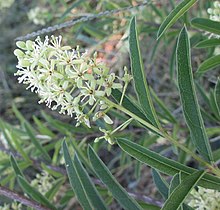Boscia angustifolia is a shrub or small tree with lanceolate leaves commonly found in the savannah zones of Africa, from Senegal moving eastwards to Sudan. It is part of the Capparaceae family.[1] The plant is also known as the rough-leaved shepherds tree.
| Boscia angustifolia | |
|---|---|

| |
| Scientific classification | |
| Kingdom: | Plantae |
| Clade: | Tracheophytes |
| Clade: | Angiosperms |
| Clade: | Eudicots |
| Clade: | Rosids |
| Order: | Brassicales |
| Family: | Capparaceae |
| Genus: | Boscia |
| Species: | B. angustifolia
|
| Binomial name | |
| Boscia angustifolia A.Rich.
| |
Description
editIt is a smooth, grey barked shrub or small tree that is capable of reaching 7 m (23 ft) in height and with a short trunk.[2] It has leaves with simple, alternate arrangement; leaf-blade is lanceolate to oblong outline with a coriaceous and glabrous upper surface, short, fine hairs beneath; it is 1.5-5 cm long and 1-1.5 cm wide, petiole is 2-7 mm long.[3][2] Flowers are greenish to white, terminal or axillary clustered in raceme type of inflorescence. Fruit is spherical berries, about 6-10 mm in diameter.[3]
Distribution
editOccurs in the Sudan and Sahel zones of West Africa, from Senegal to Nigeria and eastwards towards the Red Sea where it has been identified in Sudan and Egypt[3] then southwards towards Northern South Africa.[2]
Chemistry
editTest on parts of the species identified the methylated flavonoid, ombuin, the carboxylic acid compounds: lactic and quinic acid, and about three nitrogen methyl compounds including 1-methyl imino thieno [3,4b] naphthalene.[4][5]
Uses
editThe roots are used in decoctions to treat a variety of bacteria infection and other health issues including diarrhea, pneumonia, urinary tract infection, chest pain and boil.[6] Its leaves and fruit are used to induce purging and to act as a cholagogue.
References
edit- ^ Chini, Caterina; Bilia, Anna; Keita, Arouna; Morelli, Ivano (October 1992). "Protoalkaloids from Boscia angustifolia". Planta Medica. 58 (5): 476. doi:10.1055/s-2006-961522. PMID 17226509. S2CID 260282953.
- ^ a b c Schmelzer, Gaby H.; Gurib-Fakim, Ameenah; Schmelzer, Gabriella Harriet, eds. (2008). Medicinal Plants. PROTA. p. 22. ISBN 978-90-5782-204-9. OCLC 297222192.
- ^ a b c Baumer, Michel; Nations, Food and Agriculture Organization of the United (1983). Notes on Trees and Shrubs in Arid and Semi-arid Regions. Food & Agriculture Org. p. 114. ISBN 978-92-5-101354-0. OCLC 11071774.
- ^ Salem, MahaM; Hussein, SamehR; El-Sharawy, Reham; El-Khateeb, Ahmed; Ragab, EmanA; Dawood, KamalM; El Negoumy, SabryI.M. (2016). "Antioxidant and antiviral activities of the aqueous alcoholic leaf extract of Boscia angustifolia A. Rich. (Capparaceae) and its major component 'ombuin'". Egyptian Pharmaceutical Journal. 15 (1): 1. doi:10.4103/1687-4315.184025. S2CID 99427496.
- ^ Maroyi, Alfred (October 2019). "A review of medicinal uses, phytochemistry and biological activities of Boscia angustifolia". Journal of Pharmaceutical Sciences and Research. 11 (10): 3420–3428. ProQuest 2313059058.
- ^ Hassan, S. W.; Umar, R. A.; Lawal, M.; Bilbis, L. S.; Muhammad, B. Y.; Dabai, Y. U. (2006). "Evaluation of antibacterial activity and phytochemical analysis of root extracts of Boscia angustifolia". African Journal of Biotechnology. 5 (18). doi:10.4314/ajb.v5i18.55804 (inactive 1 November 2024).
{{cite journal}}: CS1 maint: DOI inactive as of November 2024 (link)